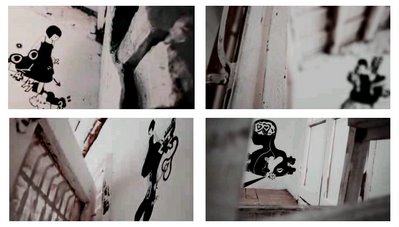Soda Green - a Little Love Song
Uploaded by
Two similar music videos, on the top is "a Little Love Song" by Taiwanese indie band "Soda Green" made around end of October2006.
The other is "Montreal" by Canadian indie band "Malajube" done Feb,2006.
One member of "a little Love Song" music video filming crew once had a comment on this coincidence conceptually, he said "Found this music video with 95% similarity on net after the whole filming process was done... it's too late to redo, so we can only force ourselves go on the post-production."
That's a fact, will any one take?
Once I drew a rabbit, although it's setup basically decided, but I thought there's something missed.
So it's been postponed months, and one day I saw a 98% similarity rabbit doll while hanging out.
Thus, fact like that, I do believe.
There is a theory I found in a book about intellectual property rights when I was working on a thesis last year. It states that all creations are created under influences from environment and society, and so on.(*)
Malajube - "Montreal -40°"
Uploaded by choufi
Information provided by one of the animators who participated production of "A Little Love Song" music video.
(*)Postscript,
From Thesis of Intellectual Property, page 83rd. by Xiong-lin Xiao.
(Ok, the following contents are translated by myself with spoken English or what.)
Creations which protected under intellectual property rights are necessarily required "originality". The Originality only required independent creation,"novelty" is not necessarily required.
Creations which only substantially similar to creations that made by others and have no novelty will not be debarred from the protection of intellectual property rights
[Sheldon V. Metro - Goldwyn Pictures Corp.,81F. 2d 49(Cir 1936 aff'd 309(1946))]
Originality is only a reason why creations is belong to its creator which is independent creation and not plagiarized.
Therefor, even if one creation is absolutely the same as one created before, but it was a result of independent creation and not plagiarized, will also be protected under intellectual property rights.
In other words, Originality here is a relative and comparative concept.
(p.30 Studies of Intellectual Property Rights (1943) by Yoshihini Kido)
{城戸芳彦『著作権法研究』(新興音楽出版社、1943. 年)}
http://www.excite.co.jp/book/product/ASIN_B000JB256M/
This is because, human thoughts and emotions were usually influenced by the past. Based on old cultures added creativity and made a new idea.
For example, western philosophy of Plato was influenced by Socrates.
Immanuel Kant's philosophy was a compromised result between the empiricists and the rationalists.
Beethoven's early works was influenced by Haydn.
In China, Zhuangzi was influenced by Laozi and Mencius was influenced by Confucius.
Japanese epic novel Nansō Satomi Hakkenden by Bakin Kyokutei was a imitation of Chinese classic novel Water Margin by Naian Shi.
(P.63 Intellectual Property Rights (1969) by Keiichi Yamamoto)
{山本桂一『著作権法』(有斐閣、昭和44年)}

No comments:
Post a Comment